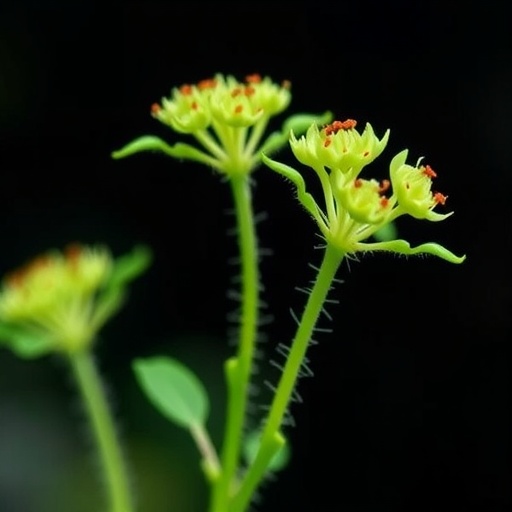In the intricate world of plant reproduction, successful fertilization depends on an exquisitely choreographed dialogue between male and female gametophytes. Flowering plants have evolved a variety of molecular signals to guide pollen tubes, the cellular structures that transport sperm cells from pollen grains to ovules. For decades, researchers have primarily focused on a class of peptides known as cysteine-rich peptides (CRPs), particularly defensin-like proteins such as LUREs, which act as chemoattractants secreted by female synergid cells. However, a groundbreaking study published in the journal Seed Biology on February 21, 2025, by Hong-Ju Li and colleagues at the University of Chinese Academy of Sciences, challenges established paradigms by unveiling a novel non-defensin peptide, designated NON-DEFENSIN PEPTIDE ATTRACTANT 1 (NPA1), that functions in pollen tube attraction within Arabidopsis thaliana. This discovery unravels heretofore unknown layers of complexity in the reproductive signaling networks of dicotyledonous plants.
The canonical understanding of pollen tube guidance has long centered on defensin-type CRPs, stabilized by multiple disulfide bridges formed by highly conserved cysteine residues. These peptides, including LURE1.2 among others, are transcriptionally regulated by the synergid-specific transcription factor MYB98, ensuring precise spatial and temporal expression. Despite extensive identification of over ten CRP-type attractants within Arabidopsis, incomplete pollen tube targeting phenotypes persisted in myb98 mutants, suggesting the existence of additional, unidentified signaling molecules. This enigmatic gap prompted Li’s team to adopt an innovative transcriptomic screening strategy targeting synergid-expressed genes downregulated in myb98 mutants but devoid of typical CRP motifs, thus setting the stage for the discovery of NPA1.
Their bioinformatics-driven approach pinpointed six candidate genes, among which AT4G02655—subsequently named NPA1—was found to be highly expressed in ovules and to possess a canonical signal peptide for secretion. Intriguingly, a close homolog, AT1G18486 (designated NPA2), displayed similar expression patterns but differed functionally. Through RT-PCR and translational fusion with green fluorescent protein (GFP), both genes were experimentally confirmed to localize specifically to synergid cells and to be regulated by MYB98 at the transcriptional level, underscoring the coordinated nature of their expression within the reproductive tissues.
A pivotal revelation emerged from structural modeling data which demonstrated that, unlike defensin-like CRPs that adopt a compact β-sheet rich fold stabilized by multiple disulfide bonds, NPA1 and NPA2 assemble into an α-helical conformation composed of five helices interconnected by only two disulfide bridges. This distinct structural architecture lacks the hallmark defensin motifs, positioning NPA1 as an unprecedented class of non-defensin peptide attractants in dicot plants. The researchers employed recombinant protein expression and purification techniques to isolate functional NPA peptides, enabling in vitro assays to quantify pollen tube attraction capabilities.
Functional assays using semi-in vitro pollen tube attraction systems revealed that NPA1 effectively attracts pollen tubes, albeit with lower potency relative to the established attractant LURE1.2. Conversely, NPA2 failed to elicit any discernible chemoattraction, indicating functional divergence despite sequence homology. Site-directed mutagenesis experiments targeting four conserved cysteine residues within NPA1 completely abrogated its pollen tube attraction and membrane-binding properties, validating these residues as critical determinants of biological activity through the maintenance of structural integrity and receptor interaction.
Further investigations demonstrated species specificity inherent to NPA1’s attraction capacity; it preferentially facilitated pollination of conspecific Arabidopsis pollen tubes and those of closely related species. This selectivity implies a role in reproductive isolation mechanisms by reinforcing species-preferential fertilization barriers. Functional complementation studies in myb98 mutants revealed that forced expression of NPA1 partially rescued pollen tube guidance defects and augmented seed set, though full restoration of fertilization efficiency was not achieved. These findings emphasize NPA1’s specialized function in guidance rather than downstream fertilization processes such as gamete fusion or seed development.
The discovery of NPA1 inaugurates a paradigm shift in our understanding of the molecular machinery governing plant reproductive signaling. It reveals evolutionary plasticity in the repertoire of peptide signals beyond the extensively studied defensin families, expanding the biochemical diversity through which plants coordinate reproductive success. The identification of a non-defensin, α-helical peptide attractant challenges traditional classifications and underscores the potential for undiscovered signaling modalities in angiosperms.
From an applied perspective, NPA1 opens new avenues for agricultural biotechnology and crop improvement. Species-specific fertilization barriers often hinder hybridization efforts and interspecific crosses vital for breeding programs aimed at trait stacking and genetic diversification. Harnessing knowledge of peptides like NPA1 could facilitate the design of synthetic attractants or molecular modulators to circumvent reproductive isolation, improving fertilization efficiencies and enabling novel breeding strategies in economically important crops.
Moreover, the structural and functional characterization of NPA1 enriches the toolkit available for synthetic biology approaches aiming to manipulate pollen tube guidance pathways. By tuning peptide-receptor interactions or engineering synthetic variants of non-defensin attractants, it may become feasible to orchestrate fertilization at unprecedented spatial precision. This innovation could revolutionize seed production technologies and contribute to food security by optimizing reproductive outcomes under variable environmental conditions.
The evolutionary insights gleaned from this study also pose compelling questions about the diversification of signaling peptides across plant lineages. Whether non-defensin attractants akin to NPA1 exist in other angiosperm clades, or how their signaling pathways integrate with canonical CRP-mediated networks, remain tantalizing areas for future research. Understanding these dynamics promises to shed light on the molecular evolution of reproductive strategies and speciation.
Ultimately, the work led by Hong-Ju Li and colleagues exemplifies the power of integrative transcriptomics, structural biology, and functional assays to reveal hidden facets of plant reproductive biology. By challenging dogmas and broadening the spectrum of known attractants, this study positions NPA1 as a pivotal molecule reshaping the landscape of pollen tube guidance research. As further investigations unfold, the molecular lexicon of plant reproduction will undoubtedly continue to evolve, mirroring the intricate complexity of life itself.
Subject of Research: Not applicable
Article Title: A non-defensin peptide NPA1 attracts pollen tube in Arabidopsis
News Publication Date: 21-Feb-2025
References:
DOI: 10.48130/seedbio-0024-0001
Web References:
- Seed Biology journal: https://www.maxapress.com/seedbio
- Direct article DOI link: http://dx.doi.org/10.48130/seedbio-0024-0001
Keywords: Applied sciences and engineering, Mathematics




